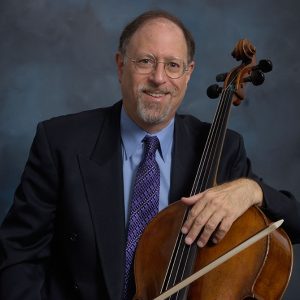
The Joy of Feuillard – A Sequential Approach to Teaching Bow Technique (Part 2 – The Sequential Method)
Robert Jesselson
Part 2 – The Sequential Method
I believe that it is important for an applied cello teacher to have an organized and logical pedagogical system in order to ensure that intermediate level students are exposed to all the technical and musical information that they need. Just as a math teacher or an English teacher uses a syllabus to create a logical succession of tasks for a young student, the applied studio string teacher should have a clear methodology to insure that all the requisite material is covered and that the student builds a secure technique based on a solid foundation. Very often I hear cellists play who clearly have “holes” in their technique or in their understanding of how the body works. They may never have analyzed how string crossings work, or know which part of the arm is active and which part is passive in playing a sautillé stroke, or how to use ballistic motions to their advantage.
There is so much material for a young musician to learn, and if the intermediate level teacher is not well organized then some important material may be left out or forgotten. Far too often string teachers neglect to cover important topics, thus leaving their students with major holes in their cello understanding and development. The teacher needs to have a “grand design” in taking the students through what they need in an organized sequential manner. If not, then the student may be missing the solid foundation required to continue building technique, repertoire, understanding of style, endurance, memorization, concentration, performance experiences, and a career. These teachers fail their students with what I call “random teaching”. They just teach a piece and work on whatever technical issues happen to appear at the moment.
I remember being shocked a few years ago when a Freshman college student came to me after having studied with the principal cellist of one of our major orchestras. This student was proud of having worked with this excellent cellist for several years, but had no idea about all the essential elements that were missing in his playing and in his basic understanding of the instrument. It was a shock to him when we started going through the fundamentals of cello technique, and when he realized how much he didn’t know. Very often I hear auditions in which a young cellist might play a Popper High School etude that he/she prepared specifically for the audition, but this student may never have played a preparatory etude by Lee or Duport or Franchomme. Or even the Popper Op. 76 “Intermediate” etudes.
Sometimes it seems that cellists who are themselves excellent players teach “improvisationally”, reacting to whatever a student brings in to the lesson rather than leading a student through a well-thought out, logical approach to technique, etudes and pieces. This may be because excellent players often have forgotten how they themselves were taught. Or it could be that they just teach lessons in order to earn a few extra bucks, after hanging up a shingle saying “Cello Lessons, $150 per hour”.
There is certainly a place for this kind of improvisational teaching – e.g. a one-time master class situation, or a student coming in for a sample lesson, or occasionally as the situation may warrant with a regular student. Certainly a lesson in which a master artist is working with an artist-level performer may fall into this category of improvisational or inspirational teaching. However, if an artist-teacher says “play this passage like a rainbow” and the student has no idea how to make something sound like a rainbow because they don’t know how to control the bow or change the color of the sound, then there is something wrong. If a teacher is responsible for the development of a student over a period of time, I think it is important for the teacher to have a clearly thought out plan for that student.
According to the philosopher Alfred North Whitehead, “the rhythms of education are in three stages: romance, precision and generalization.” Studies of successful performers have shown that many of them have been taught by a succession of teachers who embody these three stages. The beginning teacher nurtures the romance of the instrument and the joy of music; the second teacher is the technician who helps to build technique and instill discipline; and the third teacher is the artist-teacher who is able to inspire the student to artistic heights and may be more of a coach.
This country has wonderful teachers in the first category, including in public school and Suzuki programs, who help to nurture young musicians. These teachers spread the joy of playing a string instrument, and provide the basic technical information that these young musicians need. We also have fantastic artist-teachers who fit into the third category. These are teachers at major conservatories, as well as performers in orchestras, chamber groups and orchestras who serve as inspirational teachers and coaches. However I feel that we are lacking teachers who serve in the second category mentioned above. These are the teachers who can delve deeply into the details of playing an instrument, helping to build the craft of playing an instrument, while instilling self-discipline and technical competence on a high level. These are the teachers who guide a student through a healthy diet of scales, arpeggios, etudes and appropriate repertoire. Their role includes building good work habits, demanding high standards, expecting consistency, and providing a thorough understanding of left-hand and right-hand techniques.
This Blog will focus on the work of the second category of teacher, and specifically on how a teacher for an intermediate level student can build a student’s bow arm through the Feuillard Daily Exercises. These bowing variations are a perfect example of a logical and sequential approach to teaching bow technique. For me, the Feuillard is our cello “bible”. It is set up in an organized manner as a kind of syllabus for the bow. Feuillard No. 32 is all in first position, and it deals with basic bow control issues. No. 33 adds some complexity by going up to fourth position, and it requires an understanding of contact point issues and son filé, in addition to building on various techniques from No. 32. The next three pages (Feuillard No. 34-36) all deal with string crossings as the main topic, with No. 34 using 2 strings, No. 35 using 3 strings, and No. 36 using 4 strings. Understanding string crossings is one of the most important tasks for cellists. If players do not use the arm in an ergonomically correct manner, then string crossings in particular can become a major source of tendonitis.
However as with any method it is up to the teacher to be able to present the material in a productive and consequential manner. The teacher must completely know and understand the technical information, and he/she must be able to communicate it effectively to the student. The teacher should be able to anticipate the issues involved, and have several different ways of solving the problems that may occur. The teacher needs to be able to demonstrate adequately. The teacher needs to be able to set high standards for the student. And the teacher needs to know when to ask a student to repeat something, and when to move on.
We expect our students to be disciplined and to practice efficiently and effectively, but similarly we have to be disciplined in how we best use our time with the student in the lesson. Since most students come just once a week for an hour lesson it is vital that the hour is used to the fullest. For me a typical lesson will be divided into four parts: scales and arpeggios; bowing exercises; etudes; and repertoire. In the beginning of each semester I put more focus on the beginning parts of the lesson; as the semester continues there will be more attention on the etudes and repertoire. But throughout I will try to “hit” each part of the lesson for at least a few minutes. If not, the student will likely not practice whatever I don’t hear in the lesson.
Teachers have their own style of teaching, and their own approach to pedagogy and technique. However ultimately it is the responsibility of every teacher to cover all the necessary material in one way or another. The Feuillard is our “vade mecum” that insures this coverage.
My goal in this series of blogs will be to demonstrate how I teach bow technique. I will describe the pedagogical intent for each variation, and use video examples from actual lessons with my pre-college students. This series is intended for teachers, for advanced players who wish to improve their own bow technique, and for amateur players who want to explore some of these concepts for themselves.
In Blog #3 we will start with some fundamental techniques which cellists need to know before beginning the Feuillard. These include the “core” sound, the “block of sound”, how the different parts of the arm work, the Three Principles of Tone Production, and the all-important concept of Left/Right Motion.
*If you have questions or comments about The Joy of Feuillard, Dr. Robert Jesselson can be reached directly at rjesselson@mozart.sc.edu.
Subjects: Repertoire, Technique
